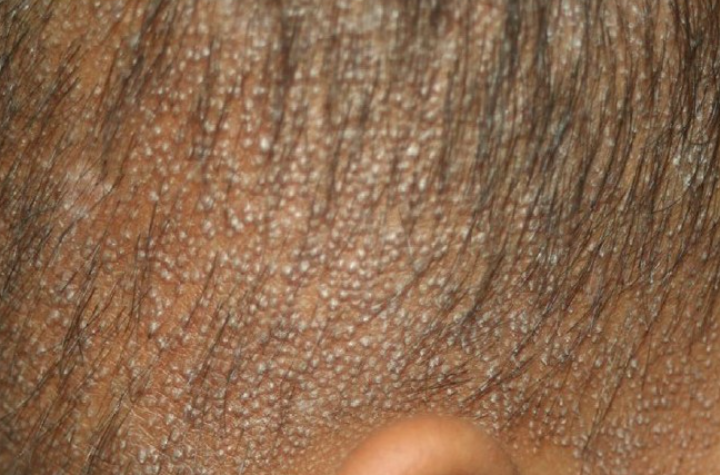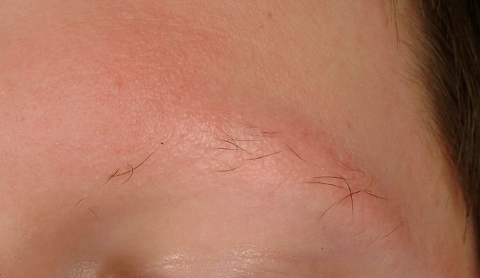Keratosis pilaris (also known as lichen pilaris or follicular keratosis) is a benign skin condition characterized by keratosis of hair follicles. ICD-10 code: L85.8
A common condition in adolescents and young adults. According to various sources, keratosis pilaris occurs in 50-80% of children and adolescents and almost 40% of adults. It appears in early childhood with peak clinical manifestations during puberty. Females are slightly more affected than males. The condition worsens in dry weather and during the winter months.
There are several variations:
- Idiopathic Keratosis pilaris.
- Three clinical variants of the inherited form.
- Keratosis follicularis spinulosa decalvans
- Ulerythema ophryogenes
- Atrophoderma vermiculata
- Inherited form (autosomal dominant type with variable gene penetrance).
- Keratosis pilaris associated with various other diseases and syndromes.
The etiology and pathogenesis are still not fully understood. For some reasons, keratin plugs form due to excess keratin, possibly due to a defect in corneocyte adhesion at the follicular opening, which inhibits new hair growth. Hair may ingrow, leading to a perifollicular inflammatory response.
Associated Conditions
- Atopic Dermatitis
- Ichthyosis Vulgaris
- Graham-Little-Piccardi-Lassueur Syndrome
- Cardiofacialcutaneous Syndrome
- Noonan syndrome
- Diabetes
- Down Syndrome
- Obesity
- Hypervitaminosis A
Clinically, keratosis pilaris is characterized by the appearance of numerous small papules (1-2 mm in diameter) with skin-colored surfaces covered with keratinized scales. These papules are localized on the extensor surfaces of the limbs, back, and buttocks. Each of these papules is formed by a keratin "plug" covering the top of the hair follicle. A red or dark red halo (perifollicular erythema) is often seen around the periphery of the papule.
As a result, the skin in the affected areas often has a "gooseflesh" or "chicken skin" appearance and feels rough and coarse to the touch, like sandpaper. Sometimes the condition can become generalized, affecting the trunk, extensor surfaces of the arms and legs.
Clinical Variants of Keratosis pilaris
Many authors distinguish clinical variants of Keratosis pilaris as separate nosological forms.
Keratosis follicularis spinulosa decalvans
Ulerythema ophryogenes
Atrophoderma vermiculata
- Folliculitis
- Atopic Dermatitis
- Milia
- Lichen spinulosus
- Lichen Nitidus
- Eruptive Vellus Hair Cysts
- Keratosis follicularis squamosa (Dohi)
- Acne
- Pityriasis rubra pilaris
- Darier Disease
- Kyrle Disease
- Scurvy
- Phrynoderma (Vitamin A Deficiency)
Treatment In many patients, the condition improves with age, but it may persist from childhood into old age. Many patients seek treatment primarily for cosmetic reasons, as keratosis pilaris patches are often asymptomatic. Scratching, wearing tight clothing, and using abrasive soaps and scrubs for self-treatment may worsen the condition. There is currently no definitive treatment.
- First-line therapy includes the prescription of keratolytics, such as 4%-12% lactic or salicylic acid lotions or creams applied twice daily, and the use of moisturizing lotions and creams. Avoiding excessive dryness is also important. Harsh soaps (deodorant soaps) should be avoided in favor of mild, moisturizing soaps and emollients applied to moist skin after bathing. If erythema is severe, short-term use of topical steroids such as triamcinolone cream (0.1%) twice daily for 10 days is recommended.
- Second-line therapy includes the use of topical retinoids to reduce hyperkeratosis and may be effective when combined with moisturizers containing 10% urea. Temporary improvement can be achieved with tretinoin ("Retin-A"), but the irritation it often causes is usually unacceptable to patients.
- Third-line therapy includes oral isotretinoin for severe disease and its clinical variants, but in most cases the disease recurs after discontinuation.
- Fourth-line therapy includes treatment of severe lesions with pulsed dye laser therapy.




